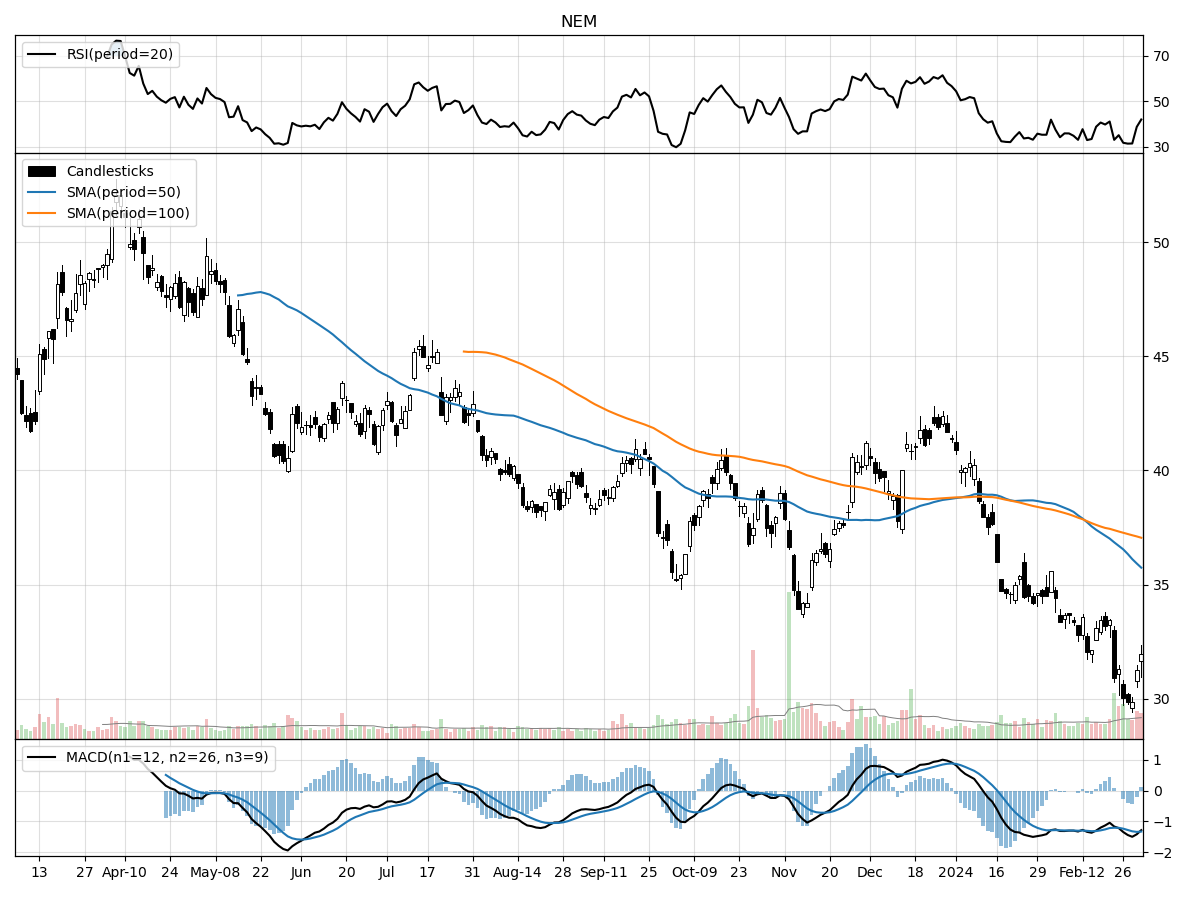Newmont Corp (NEM), Large Cap AI Study of the Week

March 5, 2024
Weekly AI Pick from the S&P 500
Company Overview
Newmont Corporation is a leading gold mining company with a history dating back to 1921, operating across North and South America, Africa, and the Asia-Pacific region. The company boasts a robust portfolio of gold reserves and resources, and also produces copper, silver, lead, and zinc. In a strategic expansion, Newmont acquired Newcrest Mining Limited in November 2023, which resulted in the reorganization of its business segments, now reporting 17 mining operations individually. Gold remains the primary source of revenue for Newmont, contributing 89% to its sales in 2023, with the remainder from co-products and by-products.
The company is recognized as the top global gold producer, controlling about five percent of worldwide mined gold production. Newmont's competitive edge is attributed to its possession of large, high-grade ore deposits in favorable mining jurisdictions and its efficient operations. The company employs various processing methods to extract precious metals, selling them as refined doré bars or raw concentrate to smelters and traders. Moreover, Newmont's financial performance is closely tied to its ESG commitments, which are integrated into its business strategy to ensure sustainable growth.
Newmont is committed to responsible mining, aligning its sustainability efforts with international standards and initiatives. The company has set ambitious environmental targets, including science-based emission reduction goals for 2030 and an aspiration to achieve carbon neutrality by 2050. Partnerships, such as with Caterpillar Inc., focus on developing electric autonomous mining systems, and Newmont invests in renewable energy projects to mitigate its climate impact. Additionally, the company has made strides in gender equality, aiming for women to hold 50% of senior leadership roles by 2030.
Despite these positive aspects, Newmont faces several risks, including market volatility, environmental liabilities, and challenges in integrating Newcrest Mining. The company's reliance on technology and global operations exposes it to system disruptions, regulatory burdens, and the need for community support. The mining industry's inherent risks and the uncertain benefits from the Newcrest transaction also pose threats to Newmont's financial stability and operational success.
By the Numbers
Annual 10-K Report Summary:
- Net income from continuing operations attributable to stockholders: Loss of $2,521 million (a decrease of $2,062 million from the previous year).
- Reclamation, remediation, and impairment charges: Significant increase (specific numbers not provided).
- Metal prices: Higher prices for gold and copper.
- Depreciation and amortization: Lower expenses (specific numbers not provided).
- Divestitures: Planned divestment of six non-core assets and a development project with a net book value of $3,419 million.
- Newcrest acquisition: Completed for $13,549 million.
- Gold sales: Increased by 2%.
- Copper sales: Increased by 82%.
- Silver, lead, and zinc sales: Declined, contributing to a 1% overall decrease in total sales.
- Costs applicable to sales: Rose by 4%.
- Exploration expenses: Increased (specific numbers not provided).
- General and administrative expenses: $299 million (a steady increase over three years).
- Interest expenses: $243 million.
- Effective income tax rate: Income and mining tax expenses at $526 million.
- Gold equivalent ounces (GEO) calculation: Assumed gold price raised to $1,400 per ounce.
- Gold production: Decreased by 30%.
- Adjusted EBITDA: $4,215 million.
Quarterly 10-Q Report Summary:
- Net income: Decrease compared to the same periods in 2022 (specific numbers not provided).
- Peñasquito mine labor strike: Significantly impacted sales volumes and halted production in Q3 2023.
- Yanacocha Sulfides project: Deferred until 2026.
- Newcrest acquisition: Expected to close in November 2023.
- Sales: Decreased by 10% over nine months; 5% reduction in Q3 2023.
- Copper sales: Increased by 26% over nine months.
- Costs applicable to sales: Decreased during the nine months ending September 30, 2023 (specific numbers not provided).
- Depreciation and amortization: Decreased (specific numbers not provided).
- Effective tax rate: Influenced by geographic income distribution and tax law changes (specific numbers not provided).
- Gold production (nine months): 3,696 thousand ounces at an average cost of $1,033 per ounce.
- Boddington mine gold equivalent ounces: Increased by 28%.
- Peñasquito mine gold production: Decreased by 72% in Q3 2023.
- Ahafo and Akyem mines gold production: Decreased (specific numbers not provided).
- NGM gold production: Increased (specific numbers not provided).
Investors should consider these key numerical changes and metrics when assessing Newmont Corporation's financial health and future prospects.
Stock Performance and Technical Analysis

When analyzing the technicals of a stock, we consider various indicators and chart patterns to determine the stock's potential future movements. For the stock in question, there are several key points to consider.
Starting with the current price of $31.94, the stock is 6 percent above its 52-week low and 38 percent below its 52-week high. This suggests that the stock has corrected significantly from its peak but has found some support above its yearly low. The fact that it is closer to the low may indicate a potential value play if the company's fundamentals are strong; however, it also points to a bearish trend in the medium term. The recent decline in price by 7.18% over the last month and 19.93% over the last three months further confirms the bearish sentiment in the short to medium term. Investors may interpret this as a period of consolidation or perhaps the early stages of a potential reversal if other indicators provide bullish signals.
Volume analysis shows that recent daily volume is higher than the longer-term average, which could indicate a heightened interest in the stock, possibly due to news or events related to the company. This increased volume doesn't necessarily dictate price direction but does indicate that any price movements are significant due to the higher number of shares being traded. The Money Flow indicators suggest that the stock is under moderate selling pressure, which aligns with the price decline over the recent periods. However, Money Flow also indicates that the stock is under accumulation, which could mean that while there is selling pressure, there are also parties accumulating shares, perhaps in anticipation of a future price increase.
The Relative Strength Index (RSI) shows that the stock is neither overbought nor oversold, which places it in a neutral zone, providing no strong signals for a reversal or continuation of the current trend. The Moving Average Convergence Divergence (MACD) being bearish at -1.32 reinforces the bearish sentiment in the market for this stock. The MACD is a trend-following momentum indicator that shows the relationship between two moving averages of the stock's price; a negative value suggests that the short-term momentum is lower than the long-term momentum, indicating bearish trends.
Overall, the technical analysis presents a stock that is in a bearish phase with a mix of selling pressure and accumulation, no clear RSI signal, and a bearish MACD. Investors should consider these indicators along with the company's fundamentals and any potential catalysts before making an investment decision. Caution is warranted, and a strategy might involve waiting for a bullish shift in some of these indicators or for the stock to establish a clearer trend before committing to a position.

The ‘Bull’ Perspective
Unlocking Value in Newmont Corporation: A Golden Opportunity for Investors
Summary:
- Robust Earnings and Revenue Growth: Newmont's strong earnings growth of 7.5% and revenue growth of 3.8% outpaces the industry average, signaling operational efficiency and market resilience.
- Strategic Acquisitions and Expansions: The upcoming acquisition of Newcrest Mining Limited and the strategic deferral of the Yanacocha Sulfides project demonstrate Newmont's prudent capital allocation and growth strategy.
- Diverse Global Operations: With operations across the globe, Newmont benefits from geopolitical diversification, reducing the risk from any single market or regulatory change.
- Strong Market Position: As a leading gold producer, Newmont's market position is bolstered by increased commodity prices, offering a hedge against inflation and market volatility.
- Commitment to Shareholder Value: Despite short-term challenges, Newmont's long-term strategy focuses on shareholder value, with potential for increased dividends and share repurchases as market conditions stabilize.
Elaboration:
- Robust Earnings and Revenue Growth:
Newmont Corporation has demonstrated a solid financial performance with its earnings growth tracking at an impressive 7.5%. This growth is supported by a 3.8% increase in revenue, highlighting the company's ability to navigate and capitalize on market conditions effectively. With approximately 90% of the S&P 500 companies reporting, Newmont's figures stand out, particularly when considering the narrow group of mega-cap tech companies that have driven much of the market's earnings growth. This robust financial health is a testament to Newmont's operational efficiency and its resilience to the volatile nature of commodity markets. - Strategic Acquisitions and Expansions:
The strategic move to acquire Newcrest Mining Limited, expected to close in November 2023, positions Newmont for a significant expansion in its gold mining operations. This acquisition, combined with the deferral of the Yanacocha Sulfides project, showcases Newmont's commitment to optimizing its investment strategy and ensuring long-term growth and stability. By carefully timing its projects and acquisitions, Newmont is setting itself up for sustainable success, even in the face of the labor strike at the Peñasquito mine and other operational challenges. - Diverse Global Operations:
Newmont's global footprint, with operations spanning from North America to Africa and Australia, provides a strategic hedge against regional volatility. This diversification mitigates the risks associated with regulatory changes, geopolitical tensions, and market fluctuations. For instance, while the Peñasquito mine in Mexico faced a labor strike, other operations like the Boddington mine in Australia continued to perform well, showcasing the benefits of Newmont's global presence. - Strong Market Position:
As one of the top gold producers in the world, Newmont is well-positioned to benefit from the rising commodity prices. Gold is traditionally seen as a safe-haven asset, and in times of economic uncertainty and inflation, its value typically increases. This provides a natural hedge for investors against market volatility. Moreover, Newmont's increase in copper sales by 26% despite overall sales decreases further solidifies its strong market position and its ability to capitalize on commodity market trends. - Commitment to Shareholder Value:
Newmont's long-term focus remains steadfast on delivering shareholder value. Despite facing increased expenses and operational disruptions, the company is taking necessary steps to ensure that it can continue to fund its investments, pay dividends, and repurchase shares. Investors can take comfort in Newmont's commitment to maintaining its financial health, which is crucial for future dividend payments and share buybacks, enhancing shareholder returns as market conditions improve.
Conclusion:
In conclusion, Newmont Corporation presents a compelling investment opportunity. The company's impressive earnings and revenue growth, strategic acquisitions, and diverse global operations position it well in the face of industry risks and market volatility. With a strong market position in gold production and a commitment to shareholder value, Newmont is poised to deliver long-term growth and profitability. Investors seeking a resilient and strategically positioned company in the commodities sector should consider Newmont as a golden addition to their investment portfolio.

The ‘Bear’ Perspective
Why Investors Should Exercise Caution with Newmont Corporation
Upfront Summary:
- Declining Net Income: Newmont Corporation's recent financials show a worrying trend with net income falling due to operational challenges, such as the Peñasquito mine strike.
- Volatile Commodity Prices: The company's reliance on gold and copper prices, which are subject to fluctuation, poses a significant risk to financial stability.
- Rising Operational Costs: Increased costs in materials, labor, and energy are pressuring the company's margins.
- Regulatory and Environmental Risks: Stringent environmental regulations and potential legal liabilities loom over Newmont's operations.
- Cybersecurity and Operational Disruptions: The company's decision to forego specific cybersecurity insurance coupled with potential global health crises can lead to significant disruptions and financial loss.
Elaboration on Points:
- Declining Net Income:
Newmont Corporation's net income has experienced a decline, which is a red flag for investors. In particular, the labor strike at the Peñasquito mine in Mexico had a substantial impact on the company's operations, causing a halt in production and a significant decrease in sales volumes. This event alone led to a stark reduction in net income compared to the same period in the previous year. The company's profitability is being tested, and with net income being a primary indicator of financial health, this downtrend could be a harbinger of further financial woes if not addressed promptly. - Volatile Commodity Prices:
The company's financial performance is heavily dependent on the prices of gold and copper, which are notoriously volatile. Gold, which accounted for a substantial portion of Newmont's revenue, has seen price fluctuations that directly affect the company's bottom line. For instance, a 10% decrease in gold prices can lead to a significant dip in revenue, considering that gold production totaled 3,696 thousand ounces at an average cost of $1,033 per ounce. This volatility presents a considerable risk, as a downturn in metal prices can lead to rapid revenue declines, leaving the company exposed to market unpredictability. - Rising Operational Costs:
Newmont has been grappling with increased operational costs, which are squeezing the company's profit margins. The cost of materials, labor, and energy has risen, with some mines reporting increased costs per ounce of gold produced. For example, the Akyem mine in Ghana saw a rise in costs alongside a decrease in gold production. These rising costs, if not managed effectively, could erode profitability and reduce the company's ability to invest in growth opportunities or return value to shareholders. - Regulatory and Environmental Risks:
The company operates in a highly regulated environment with stringent environmental standards. Compliance with these regulations can be costly, and any breaches can result in hefty fines and reputational damage. For example, cleanup liabilities at sites like the Midnite uranium mine pose a significant financial risk. Furthermore, changes in regulatory policies can lead to revisions in reserve and resource information, adding uncertainty to the company's future projections and potentially leading to asset write-downs. - Cybersecurity and Operational Disruptions:
Newmont's decision to drop specific cybersecurity insurance raises concerns about its vulnerability to cyberattacks, which could lead to unrecoverable financial losses. Additionally, global health crises, such as the COVID-19 pandemic, have shown the potential to disrupt operations significantly. The company's recent history includes putting sites into care and maintenance, which directly affects cash flow and the ability to meet financial obligations. Such disruptions not only impact production but also investor confidence, which is critical for maintaining stock value.
In conclusion, while Newmont Corporation is a major player in the gold mining sector, the combination of declining net income, commodity price volatility, rising operational costs, regulatory burdens, and potential cybersecurity threats pose significant risks for investors. Prudent investors should consider these factors carefully when evaluating the company's stock for their portfolio.




Comments ()